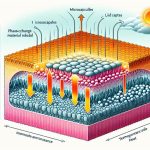You might be wondering how smart fabrics can keep you comfortable in both hot and cold weather. The secret lies in phase-change materials (PCMs) that dynamically manage thermal energy. These materials absorb, store, and release heat as they shift between solid and liquid states. But how exactly do PCMs work, and what makes them so effective in textiles? Understanding the underlying science could change the way you think about clothing and its role in energy efficiency and comfort. Curious about the types of PCMs and how they're integrated into fabrics? Let's explore further.
Table of Contents
Key Takeaways
- PCMs in smart fabrics manage temperature by absorbing, storing, and releasing heat through phase transitions.
- Organic PCMs like paraffins and fatty acids provide flexibility, sustainability, and high thermal storage capacity.
- Inorganic PCMs, such as salt hydrates, offer superior stability, durability, and thermal conductivity for consistent temperature regulation.
- Fabric enhancement techniques like coating, dyeing, and surface modification ensure effective PCM integration and thermal regulation.
- Smart fabrics with PCMs reduce reliance on external heating or cooling, promoting energy efficiency and sustainability.
Understanding Phase-Change Materials
At the heart of smart fabrics, phase-change materials (PCMs) play an essential role in managing temperature by absorbing, storing, and releasing heat.
You'll find that understanding the material properties and thermal behavior of PCMs is vital for mastering fabric technology and achieving performance optimization. These materials shift between solid and liquid states at specific temperatures, a process that allows them to either absorb excess heat or release it when temperatures drop.
When integrated into textiles, PCMs enhance thermal regulation, making fabrics more adaptive to changing environmental conditions. You won't just get a fabric that feels comfortable; you'll get one that actively manages your body's microclimate.
The key lies in the precision engineering of these materials. By fine-tuning their thermal behavior, you can create textiles that maintain consistent comfort levels, whether you're in a hot or cold environment.
Moreover, the integration of PCMs into fabrics isn't just about comfort; it's about performance optimization. Athletes, outdoor enthusiasts, and even first responders benefit from garments that help manage body temperature efficiently.
Mastering the use of phase-change materials in smart fabrics means creating textiles that excel in both performance and comfort.
Thermal Energy Storage
Building on the advantages of phase-change materials, thermal energy storage in smart fabrics takes temperature regulation to the next level by efficiently capturing and releasing heat.
Imagine you're wearing a jacket that adjusts to your body temperature, keeping you warm when it's cold and cool when it's hot. This isn't just convenience; it's energy efficiency at its best.
By storing thermal energy, these fabrics reduce the need for external heating or cooling systems, leading to significant energy savings.
You'll appreciate that this technology doesn't just benefit individual comfort. It also plays an essential role in promoting sustainable technology.
Traditional heating and cooling methods consume vast amounts of energy, often derived from non-renewable sources. Smart fabrics equipped with thermal energy storage can alleviate some of this demand, making them a more sustainable choice.
Moreover, these fabrics offer a competitive edge in various applications, from outdoor gear to everyday clothing, even in medical textiles where precise temperature control is crucial.
Mechanism of Action
You might wonder how smart fabrics can adjust to your body temperature so seamlessly. The secret lies in phase-change materials (PCMs), which are embedded in these textiles. When your body temperature rises, the PCMs absorb excess heat by changing from a solid to a liquid state. This process, known as thermal regulation, ensures you stay cool. Conversely, when temperatures drop, the PCMs solidify, releasing the stored heat and keeping you warm.
Here's a quick breakdown of the PCM mechanism:
| Stage | Action |
|---|---|
| Heating Up | PCMs absorb heat and melt |
| Cooling Down | PCMs solidify and release heat |
| Thermal Regulation | Maintains ideal body temperature |
This cycle of absorption and release not only enhances your comfort but also boosts energy efficiency. Since PCMs can store and release significant amounts of thermal energy, they reduce the need for external heating or cooling systems, making your clothing more sustainable.
Types of PCMs
When exploring types of phase-change materials (PCMs) used in smart fabrics, you'll encounter organic and inorganic options. Organic PCMs, like paraffins and fatty acids, offer flexibility and adaptability.
In contrast, inorganic PCMs, such as salt hydrates, provide higher thermal conductivity and stability.
Organic Phase-Change Materials
Among the various kinds of phase-change materials, natural PCMs stand out for their versatility and sustainability. These materials often originate from organic sources, making them a more eco-conscious choice compared to their artificial counterparts.
You'll appreciate that natural PCMs, like paraffin and fatty acids, offer sustainable production methods that align with the increasing demand for eco-friendly technologies.
When selecting natural PCMs for intelligent fabrics, you're not just picking a material; you're choosing a solution that can effectively absorb, store, and release thermal energy. This capability ensures that your intelligent fabrics can maintain ideal temperatures, enhancing wearer comfort in a variety of climates.
Natural PCMs also demonstrate excellent thermal stability and a high latent heat storage capacity, making them highly effective for thermal regulation.
You can seamlessly integrate these materials into textiles without compromising fabric quality or comfort. Their biodegradability further guarantees that end-of-life disposal won't harm the environment.
Inorganic Phase-Change Materials
Inorganic phase-change materials (PCMs) provide a robust and reliable alternative for thermal regulation in smart fabrics. These materials, such as salt hydrates and metallic alloys, excel in maintaining consistent temperatures due to their high latent heat storage capacity and thermal conductivity. When integrated into synthetic fibers, inorganic PCMs can greatly enhance the fabric's ability to manage heat, making them ideal for environments requiring strict thermal control.
You'll find that inorganic PCMs outperform their organic counterparts in terms of stability and durability. Their ability to withstand higher temperatures without degradation makes them particularly suited for applications where resilience is paramount. Additionally, inorganic PCMs can be engineered to have precise melting points, allowing for highly tailored thermal management solutions.
Incorporating inorganic PCMs into synthetic fibers also significantly enhances energy efficiency. By effectively regulating temperature, these smart fabrics reduce the need for additional heating or cooling, thereby conserving energy. This not only leads to cost savings but also contributes to environmental sustainability efforts.
Textile Integration
When you think about smart fabrics, it's important to understand how they're integrated into textiles.
You'll find that fabric application techniques play a key role in ensuring these fabrics are both functional and wearable.
Additionally, maintaining comfort is essential for practical, everyday use.
Fabric Application Techniques
Integrating smart fabrics into everyday textiles requires innovative methods that seamlessly blend technology with material. You need to focus on fabric coating and manufacturing processes to guarantee that the phase-change materials (PCMs) are incorporated effectively. Fabric coating involves applying a thin layer of PCM onto the textile surface. This allows the fabric to regulate temperature without compromising its flexibility. The manufacturing processes must be precise to maintain the fabric's integrity and functionality.
To enhance the fabric's performance, consider dyeing techniques and surface modification. Dyeing techniques involve embedding PCMs directly into the fibers during the dyeing process, ensuring uniform distribution. Surface modification, on the other hand, alters the fabric's exterior to improve PCM adherence and effectiveness. Both methods are essential for creating textiles that offer advanced thermal regulation.
Here's a quick overview of these methods:
| Technique | Description | Benefits |
|---|---|---|
| Fabric Coating | Applying PCM layer onto fabric | Maintains flexibility |
| Manufacturing Processes | Precise integration of PCMs | Ensures functionality |
| Dyeing Techniques | Embedding PCMs into fibers during dyeing | Uniform distribution |
| Surface Modification | Altering fabric exterior for better PCM adherence | Enhanced thermal regulation |
Wearability and Comfort
Ensuring wearability and comfort is vital when integrating smart fabrics into everyday clothing. You can't overlook how wearable technology should seamlessly blend into your wardrobe. Focus on comfort design to guarantee that these advanced materials don't just perform well but also feel good against your skin.
When choosing smart fabrics, pay attention to:
- Fabric breathability: Guaranteeing that your fabric allows air to circulate prevents overheating and maintains comfort.
- Flexibility features: Your clothing should move with you. Flexible materials adapt to your body's movements, enhancing overall wearability.
- Weight and texture: Lightweight fabrics with a pleasant texture minimize discomfort and maximize wearability.
To master the art of integrating smart fabrics, prioritize fabrics that maintain their technical capabilities without compromising on comfort. The right balance ensures that the fabric not only performs but also feels natural. Fabric breathability and flexibility features are essential in achieving this balance.
Benefits of Smart Fabrics
Smart fabrics offer numerous advantages that can enhance both daily life and specialized activities. One of the most important benefits is their contribution to sustainability. By integrating smart fabrics into the fashion industry, you're not only embracing cutting-edge technology but also promoting eco-friendly practices. These materials can adapt to temperature changes, reducing the need for multiple layers of clothing and decreasing overall fabric waste. This efficiency aligns perfectly with the industry's growing focus on sustainability.
In addition to their environmental benefits, smart fabrics also provide substantial health advantages. Imagine clothing that monitors your essential signs or detects changes in your body temperature, alerting you to potential health issues before they become serious. This proactive approach to health can lead to early diagnosis and timely intervention, enhancing your overall well-being.
Moreover, smart fabrics can greatly enhance performance in various activities. For athletes, these materials can regulate body temperature, wick away sweat, and even provide real-time feedback on physical exertion. This level of performance enhancement ensures that you're always at your best, whether you're running a marathon or simply going about your daily routine.
With smart fabrics, you're not just wearing clothes; you're wearing technology that enriches your life.
Applications in Clothing
You'll find smart fabrics making waves in various types of clothing, from everyday wear to high-performance athletic gear. These fabrics, embedded with phase-change materials, adapt to your body's temperature, enhancing comfort and performance. The fashion industry is keenly adopting these innovations to offer consumers clothing that's not only stylish but also functional.
In performance wear, smart fabrics are indispensable. Athletes benefit from garments that regulate temperature, wick moisture, and improve circulation. This leads to better endurance and reduced risk of overheating. Imagine running a marathon in a shirt that cools you down when you're hot and insulates you when it's cold—that's the power of phase-change materials.
Here are some key applications of smart fabrics in clothing:
- Athletic Gear: Enhances performance by regulating body temperature and managing sweat.
- Casual Wear: Provides everyday comfort with adaptive temperature control.
- Specialized Apparel: Used in extreme conditions like mountaineering or space travel for ideal thermal regulation.
The potential doesn't stop there. The fashion industry is increasingly exploring how these materials can be integrated into stylish designs, making functional fashion a reality. By embracing smart fabrics, you're not just keeping up with trends; you're stepping into the future of clothing.
Challenges and Limitations
When considering smart fabrics, you'll encounter challenges such as temperature regulation issues and concerns about durability and longevity.
The cost and scalability of producing these advanced textiles also pose significant obstacles. Understanding these limitations is essential for addressing them effectively.
Temperature Regulation Issues
One of the main challenges with smart fabrics is their inconsistent ability to regulate temperature effectively. While phase-change materials (PCMs) offer innovative solutions for heat regulation and climate control, they often fall short in real-world applications. You might find that these fabrics don't always respond to temperature changes as swiftly as needed, leading to discomfort.
Several factors contribute to these temperature regulation issues:
- Material Limitations: The PCMs embedded in smart fabrics sometimes can't store or release heat efficiently, reducing their overall effectiveness.
- Environmental Variability: Different climates and activities require varying levels of heat regulation, making it challenging for one fabric to meet all needs.
- Integration Challenges: Combining PCMs with other fabric materials can result in compromised performance, impacting both comfort and functionality.
When you're looking for smart fabrics that promise climate control, it's essential to understand these limitations. The science behind PCMs is promising, but the technology still has a way to go before it can offer consistent and reliable temperature regulation in all conditions.
Durability and Longevity
Beyond temperature regulation, another important challenge with smart fabrics is guaranteeing their durability and longevity. When you invest in high-tech textiles, you expect them to last, right? Phase-change materials need to withstand repeated usage, washing, and environmental exposure without losing their functional properties. Longevity testing becomes critical here. You'll want to understand how these materials hold up over time, especially under real-world conditions.
Material degradation is a primary concern. The microcapsules containing phase-change materials can degrade, leading to a loss of thermal regulation capabilities. This deterioration can be sped up by factors like UV exposure, moisture, and mechanical stress.
So, how do you ensure your smart fabric won't fail prematurely? Rigorous testing protocols simulate years of wear and tear in a condensed timeframe. By grasping these stressors, developers can enhance the resilience of the materials.
But let's be honest, even the most advanced fabrics aren't immune to wear. A thorough approach to longevity testing helps pinpoint weak points and create solutions. As you explore further into the realm of smart fabrics, acknowledging these challenges empowers you to make informed decisions, optimizing both performance and lifespan.
Cost and Scalability
Managing the cost and scalability of smart fabrics uncovers significant challenges that could hinder widespread adoption. You need to contemplate several factors that impact the feasibility of bringing smart fabrics to a larger market.
First, the complex manufacturing processes required for embedding phase-change materials into textiles can be cost-prohibitive. These processes often involve sophisticated machinery and materials that aren't yet optimized for high-volume production.
Additionally, production efficiency remains a critical hurdle. If you're aiming for scalability, enhancing production efficiency is non-negotiable. Current methods aren't always streamlined, leading to high waste and low yield, which drive up costs and limit output.
Contemplate the following challenges:
- High initial investment: Setting up advanced manufacturing facilities demands significant capital, which can be a barrier for new entrants.
- Material costs: High-quality phase-change materials are still expensive, making the final product costly for consumers.
- Technical expertise: Mastering the intricacies of these advanced manufacturing processes requires specialized knowledge, limiting the pool of qualified technicians.
Overcoming these obstacles will require innovation and investment in research to develop more efficient manufacturing processes and reduce material costs. Only then can the promise of smart fabrics be fully realized on a global scale.
Future Innovations
Imagine wearing a shirt that can monitor your heart rate, adjust its temperature, and even charge your devices. The future of phase-change materials in smart fabrics is about to revolutionize how you interact with your clothing.
As we look ahead, addressing sustainability concerns will be paramount. The materials and processes used must minimize environmental impact to gain consumer acceptance. You'll want to feel confident that your smart clothing not only benefits you but also the planet.
Manufacturing advancements are paving the way for these innovations. With new techniques, we can integrate sophisticated sensors and energy storage into fabrics without compromising comfort. This design flexibility will allow you to wear high-performance clothing that looks and feels just like regular apparel.
Imagine the seamless integration of technology into your everyday wardrobe, enhancing your life without any trade-offs.
Think about it: shirts that adapt to your body's needs, fabrics that can charge your phone on the go, and garments that communicate with other smart devices. This isn't science fiction; it's the next step in wearable technology.
As these advancements become more refined, you'll be at the forefront of a new era in smart fabrics.
Market Trends
In recent years, the market for smart fabrics has seen significant growth as consumers increasingly seek out innovative and functional clothing. Your desire for garments that adapt to changing conditions and offer more than just style is driving this trend. Market analysis reveals a notable shift in consumer preferences toward versatile, high-performance fabrics that incorporate advanced technologies like phase-change materials.
To meet these evolving demands, manufacturers are focusing on several key areas:
- Sustainability: Eco-friendly options are no longer a niche market but a mainstream expectation. You're likely looking for fabrics that not only perform well but also minimize environmental impact.
- Customization: The ability to tailor smart fabrics to specific needs, whether for sports, medical applications, or everyday wear, is increasingly important. Customizable options empower you to choose garments that fit your unique requirements.
- Durability: Long-lasting materials that maintain their smart functionalities over time offer better value, appealing to your sense of practicality and investment in quality.
Frequently Asked Questions
Are Phase-Change Materials Safe for People With Sensitive Skin?
Did you know that 20% of people experience skin reactions? When considering sensitivities and allergies, phase-change materials generally pose minimal dermatological concerns. However, always test on a small area first to guarantee safety for sensitive skin.
How Do Phase-Change Materials Affect the Weight of the Fabric?
Phase-change materials slightly increase fabric weight, but you'll find the benefits of fabric insulation and temperature regulation outweigh this. The added weight is minimal yet essential for maintaining comfort and efficiency in various conditions.
What Are the Environmental Impacts of Producing Phase-Change Materials?
Imagine a ticking time bomb. You're concerned about energy consumption and waste disposal. Toxic chemicals in production lead to significant air pollution. Mastering these impacts is essential for a sustainable future in smart fabrics.
Can Phase-Change Materials Be Recycled or Reused in New Fabrics?
You can indeed recycle phase-change materials, enhancing their recycling potential and contributing to sustainable practices. These materials can be reused in new fabric applications, maintaining their functionality and benefits, while reducing environmental impact.
How Do You Care for and Clean Fabrics With Phase-Change Materials?
Think of caring for your smart fabrics like preserving a masterpiece. For fabric longevity, use gentle cleaning techniques, avoid harsh detergents, and air dry. Maintenance involves regular inspections to guarantee preservation of the phase-change properties.
- A Deep Dive Into Crepe Charmeuse: the Best of Both Worlds - June 20, 2025
- The Pros and Cons of Using Charmeuse Fabric for Gowns and Dresses - June 20, 2025
- Designing With Printed Charmeuse: Tips for Patterns and Projects - June 20, 2025







